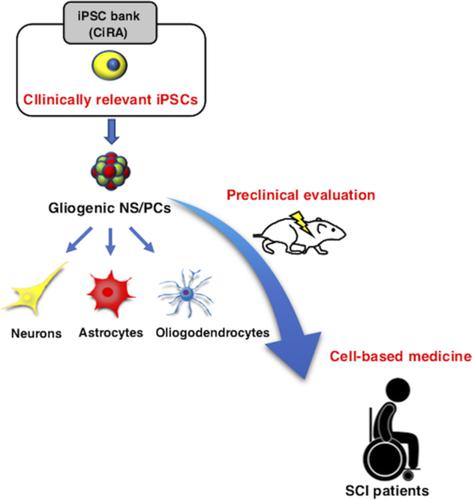当前位置:
X-MOL 学术
›
Stem Cells Transl. Med.
›
论文详情
Our official English website, www.x-mol.net, welcomes your
feedback! (Note: you will need to create a separate account there.)
A robust culture system to generate neural progenitors with gliogenic competence from clinically relevant induced pluripotent stem cells for treatment of spinal cord injury
STEM CELLS Translational Medicine ( IF 5.4 ) Pub Date : 2020-11-23 , DOI: 10.1002/sctm.20-0269 Yasuhiro Kamata 1, 2 , Miho Isoda 1, 3 , Tsukasa Sanosaka 1 , Reo Shibata 2 , Shuhei Ito 2 , Toshiki Okubo 2 , Munehisa Shinozaki 1 , Mitsuhiro Inoue 1, 3 , Ikuko Koya 1 , Shinsuke Shibata 1 , Tomoko Shindo 1 , Morio Matsumoto 2 , Masaya Nakamura 2 , Hideyuki Okano 1 , Narihito Nagoshi 2 , Jun Kohyama 1
STEM CELLS Translational Medicine ( IF 5.4 ) Pub Date : 2020-11-23 , DOI: 10.1002/sctm.20-0269 Yasuhiro Kamata 1, 2 , Miho Isoda 1, 3 , Tsukasa Sanosaka 1 , Reo Shibata 2 , Shuhei Ito 2 , Toshiki Okubo 2 , Munehisa Shinozaki 1 , Mitsuhiro Inoue 1, 3 , Ikuko Koya 1 , Shinsuke Shibata 1 , Tomoko Shindo 1 , Morio Matsumoto 2 , Masaya Nakamura 2 , Hideyuki Okano 1 , Narihito Nagoshi 2 , Jun Kohyama 1
Affiliation

|
Cell‐based therapy targeting spinal cord injury (SCI) is an attractive approach to promote functional recovery by replacing damaged tissue. We and other groups have reported the effectiveness of transplanting neural stem/progenitor cells (NS/PCs) derived from human induced pluripotent stem cells (hiPSCs) in SCI animal models for neuronal replacement. Glial replacement is an additional approach for tissue repair; however, the lack of robust procedures to drive iPSCs into NS/PCs which can produce glial cells has hindered the development of glial cell transplantation for the restoration of neuronal functions after SCI. Here, we established a method to generate NS/PCs with gliogenic competence (gNS/PCs) optimized for clinical relevance and utilized them as a source of therapeutic NS/PCs for SCI. We could successfully generate gNS/PCs from clinically relevant hiPSCs, which efficiently produced astrocytes and oligodendrocytes in vitro. We also performed comparison between gNS/PCs and neurogenic NS/PCs based on single cell RNA‐seq analysis and found that gNS/PCs were distinguished by expression of several transcription factors including HEY2 and NFIB. After gNS/PC transplantation, the graft did not exhibit tumor‐like tissue formation, indicating the safety of them as a source of cell therapy. Importantly, the gNS/PCs triggered functional recovery in an SCI animal model, with remyelination of demyelinated axons and improved motor function. Given the inherent safety of gNS/PCs and favorable outcomes observed after their transplantation, cell‐based medicine using the gNS/PCs‐induction procedure described here together with clinically relevant iPSCs is realistic and would be beneficial for SCI patients.
中文翻译:

一种强大的培养系统,可从临床相关的诱导多能干细胞中产生具有胶质生成能力的神经祖细胞,用于治疗脊髓损伤
针对脊髓损伤(SCI)的基于细胞的治疗是一种通过替换受损组织来促进功能恢复的有吸引力的方法。我们和其他小组报告了在 SCI 动物模型中移植源自人类诱导多能干细胞 (hiPSC) 的神经干/祖细胞 (NS/PC) 用于神经元替代的有效性。胶质替代是组织修复的另一种方法;然而,缺乏将 iPSC 驱动到可以产生神经胶质细胞的 NS/PC 的稳健程序阻碍了神经胶质细胞移植的发展,以恢复 SCI 后的神经元功能。在这里,我们建立了一种生成具有针对临床相关性优化的胶质生成能力 (gNS/PC) 的 NS/PC 的方法,并将它们用作 SCI 治疗性 NS/PC 的来源。我们可以成功地从临床相关的 hiPSC 中生成 gNS/PC,从而在体外有效地产生星形胶质细胞和少突胶质细胞。我们还基于单细胞 RNA-seq 分析对 gNS/PC 和神经源性 NS/PC 进行了比较,发现 gNS/PC 通过几种转录因子的表达来区分,包括HEY2和NFIB。在 gNS/PC 移植后,移植物没有表现出肿瘤样组织形成,表明它们作为细胞治疗来源的安全性。重要的是,gNS/PCs 触发了 SCI 动物模型的功能恢复,脱髓鞘轴突的髓鞘再生和运动功能的改善。鉴于 gNS/PC 的固有安全性和移植后观察到的良好结果,使用此处描述的 gNS/PC 诱导程序和临床相关 iPSC 的基于细胞的药物是现实的,并且对 SCI 患者有益。
更新日期:2020-11-23
中文翻译:

一种强大的培养系统,可从临床相关的诱导多能干细胞中产生具有胶质生成能力的神经祖细胞,用于治疗脊髓损伤
针对脊髓损伤(SCI)的基于细胞的治疗是一种通过替换受损组织来促进功能恢复的有吸引力的方法。我们和其他小组报告了在 SCI 动物模型中移植源自人类诱导多能干细胞 (hiPSC) 的神经干/祖细胞 (NS/PC) 用于神经元替代的有效性。胶质替代是组织修复的另一种方法;然而,缺乏将 iPSC 驱动到可以产生神经胶质细胞的 NS/PC 的稳健程序阻碍了神经胶质细胞移植的发展,以恢复 SCI 后的神经元功能。在这里,我们建立了一种生成具有针对临床相关性优化的胶质生成能力 (gNS/PC) 的 NS/PC 的方法,并将它们用作 SCI 治疗性 NS/PC 的来源。我们可以成功地从临床相关的 hiPSC 中生成 gNS/PC,从而在体外有效地产生星形胶质细胞和少突胶质细胞。我们还基于单细胞 RNA-seq 分析对 gNS/PC 和神经源性 NS/PC 进行了比较,发现 gNS/PC 通过几种转录因子的表达来区分,包括HEY2和NFIB。在 gNS/PC 移植后,移植物没有表现出肿瘤样组织形成,表明它们作为细胞治疗来源的安全性。重要的是,gNS/PCs 触发了 SCI 动物模型的功能恢复,脱髓鞘轴突的髓鞘再生和运动功能的改善。鉴于 gNS/PC 的固有安全性和移植后观察到的良好结果,使用此处描述的 gNS/PC 诱导程序和临床相关 iPSC 的基于细胞的药物是现实的,并且对 SCI 患者有益。











































 京公网安备 11010802027423号
京公网安备 11010802027423号